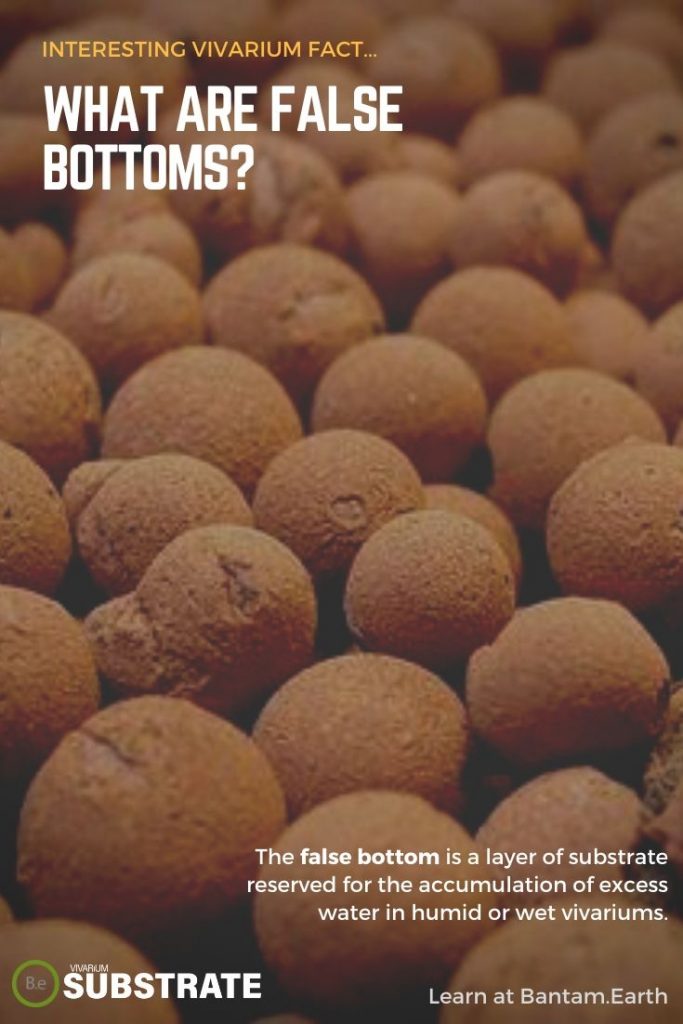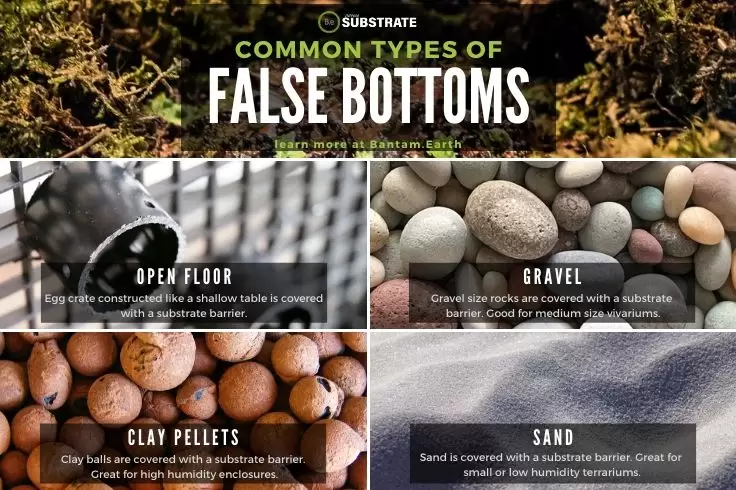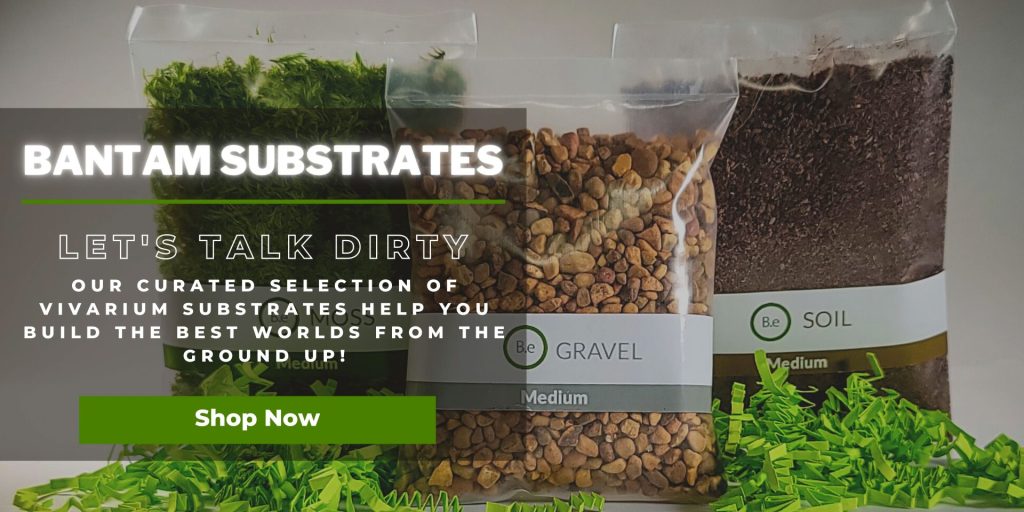When constructing a bioactive vivarium from the ground up, there are things that should be considered that don’t always meet the eye. What I mean by that is assuring the longevity of plants and animals will depend greatly on how you prepare the enclosure during the early stage of development.
Installing a proper area of drainage in a terrarium will allow the overall environment to be healthier as well as offer better control over excess water and humidity levels. This guide will provide a better understanding of the drainage layer and how to effectively use false bottoms within an enclosure.
Table Of Contents:
ToggleThe Drainage Layer
In the vivarium substrate article, the substrate is divided into three subdivisions. The drainage layer makes up the majority of the Base Horizon category. This layer will almost always consist of a material that makes up the false bottom and some type of substrate barrier.
The combination of these two elements will allow water and microfauna access to and from the drainage layer while keeping the substrate, inhabitants, and plants separated.
Having a drainage layer is vital to enclosures that stock vivarium plants and/or organisms for a couple of reasons. Besides having a place for extra water to fall during watering, humidity levels are easier to maintain when the standing water evaporates back to the upper parts of the tank.
Healthy bacteria and microfauna, like springtails and isopods, that break down waste and other toxins will accumulate here as well. These microorganisms will need a consistently saturated environment like the kind the base horizon provides to sustain well-being.
What Are False Bottoms?
The false bottom is a layer of substrate reserved for the accumulation of excess water in humid or wet vivariums. The term “false bottom” refers to the fact that the usable surface space within a tank for scaping and inhabitants stops just above the substrate barrier. We will go more into substrate barriers further down.


During the process of rehydration, the water well often needs a place to drain. Furthermore, allowing substrates to avoid over-saturation and root rot. Having a reservoir for standing water to build up allows evaporation to take place… Providing a steady amount of consistent moisture to circulate throughout the enclosure.
Types Of False Bottoms
There are many ways to establish a false bottom in the foundational layer. The deciding factor will depend on the biotype being constructed, the overall size of the vivarium, and personal preference. Many enthusiasts will opt for the lightest method possible to eliminate the potential risk of damage.
In addition, a lighter terrarium is easier to move later. Below you will find a complete list of common ways false bottoms are typically constructed:


Open Floor Method
As the name suggests, the open floor method utilizes some sort of material constructed like a shallow table covered with a substrate barrier to provide a false bottom. Tools like egg crates, or upside-down containers work great for this method.
Pieces of PVC pipe can also be used as table legs to keep the false bottom from falling through in weak areas. This is the lightest method on this list but has the least amount of surface space available for bacteria to reside.
Gravel Method
The gravel method of building a false bottom drainage layer is the heavier alternative to the first option. In this process, small rocks are used to fill up the base horizon followed by the substrate barrier covering the rocks.
Depending on the type of stones used, rocks can offer more surface space for bacteria to populate. In addition, some rocks can act as a buffer to help regulate water PH.
Sand Method
The sand method is a great alternative for smaller tanks or terrariums that are going to have low humidity levels. This process is the exact same as the gravel method with the exception of coarse-grained sand being used instead of rocks.
With sand being smaller in particle size than gravel, water will quickly consume the drainage layer making this method better for plants that may go long periods without water.
Clay Method
The clay method, in my opinion, is the best practice for medium to large-scale vivariums. Clay balls, like Hydroton, are used as an alternative to gravel in the same fashion.
This offers the same amount (if not more) of bacteria surface space as gravel but will weigh a lot less. Clay also has the ability to absorb water allowing the drainage layer to accumulate much more water than the sand method alternative.
Substrate Barriers
A substrate barrier is a material used to separate substrate into individual layers. When used correctly, substrate barriers will only allow water and microorganisms to pass between isolated areas. This material should be strong, non-toxic, and able to withstand decay for long periods of time.
This is virtually a barrier you won’t be tampering with once the vivarium is set up. It would be highly recommended to go with something that will last a long time. There are a number of objects that can be used to physically divided the false bottom from the upper substrates.
- Draining Mesh is the most popular material used in the hobby. This is mainly due to its durability and a small amount of space usage.
- Peat Moss can also be used to separate substrate layers with the added benefit of lower water PH/hardness.
- Cotton Foam like the kind used in aquarium filters can also be used as a suitable substrate divider.
In Summary
Hopefully, after reading this guide, you have a much better understanding of false bottoms. Drainage plugs can be installed allowing water to easily be removed from this layer. Furthermore, aquarium heaters and other similar tools can easily be stored within the false bottom…
Offering the opportunity to have a cleaner, more natural enclosure. If you had any more questions regarding the base horizon, feel free to let us know below.


Frequently Asked Questions
False bottoms can be made of materials such as egg crates, aquarium screens, pea gravel, clay pellets, hydroton, or expanded clay aggregate.
Many gardeners also use reptile carpet or the flexible plastic mesh used to create the bottom of a raised planter bed.
No, a false bottom is not recommended when building a terrarium. A false bottom helps create a drainage layer, which helps prevent overwatering and root rot of the plants growing in your terrarium.
A drainage layer, however, is strongly recommended for all terrariums.
A False Bottom in a terrarium serves the purpose of creating an additional layer within the terrarium, which aids in the drainage of excess water from the terrarium soil.
This helps prevent the soil from becoming oversaturated and creating an unhealthy environment for the plants and animals living in the terrarium.
Yes, you can use sand for a false bottom in a terrarium. Sand allows for increased drainage and thus provides better ventilation for the plants in the terrarium.
Additionally, it makes checking the soil easier, since you can see the roots without shoveling or excavating. However, be sure to add a layer of activated charcoal over the sand before you add soil so that water is not obstructed and the organisms in the soil are not deprived of oxygen.


